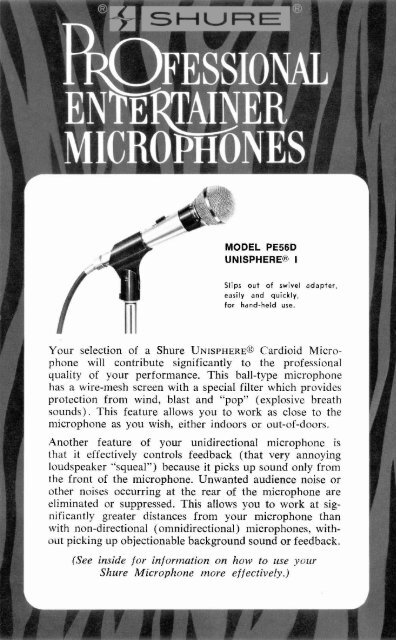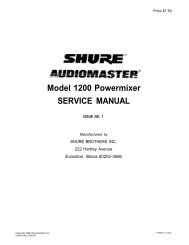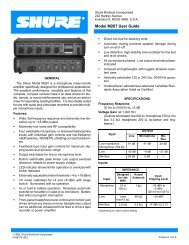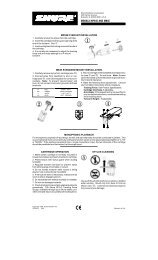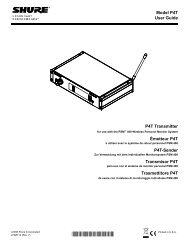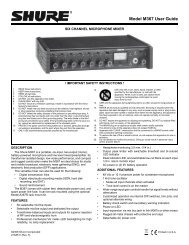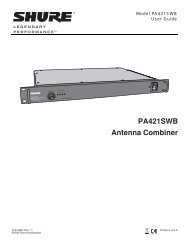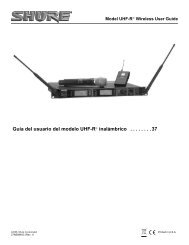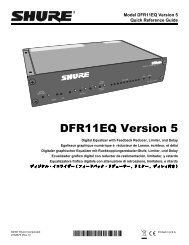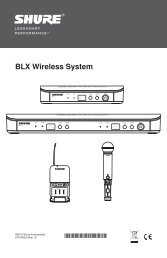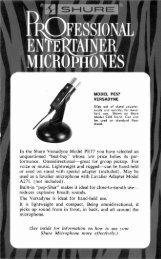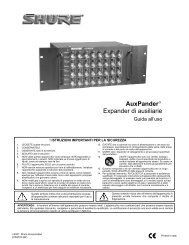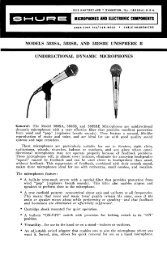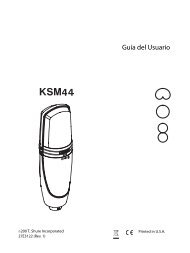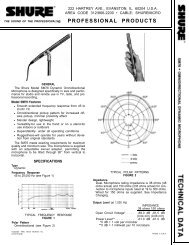Shure PE56D User Guide
Shure PE56D User Guide
Shure PE56D User Guide
Create successful ePaper yourself
Turn your PDF publications into a flip-book with our unique Google optimized e-Paper software.
MODEL <strong>PE56D</strong>UNISPHERED ISlips out of swivel adapter,easily and quickly,for hand-held use.Your selection of a <strong>Shure</strong> UNISPHERE@ Cardioid Microphonewill contribute significantly to the professionalquality of your performance. This ball-type microphonehas a wire-mesh screen with a special filter which providesprotection from wind, blast and "pop" (explosive breathsounds). This feature allows you to work as close to themicrophone as you wish, either indoors or out-of-doors.Another feature of your unidirectional microphone isthat it effectively controls feedback (that very annoyingloudspeaker "squeal") because it picks up sound only fromthe front of the microphone. Unwanted audience noise orother noises occurring at the rear of the microphone areeliminated or suppressed. This allows you to work at significantlygreater distances from your microphone thanwith non-directional (omnidirectional) microphones, withoutpicking up objectionable background sound or feedback.(See inside for information on how to use your<strong>Shure</strong> Microphone more effectively.)
HOW TO CONTROL FEEDBACKA performer's number one enemy in using a microphone is"feedback." This is a harsh hum, howl or squeal which occurswhen the microphone picks up sound from theloudspeakers, re-amplifies and rebroadcasts it over andover again.The key factor in the prevention of feedback is the positionof the loudspeakers in relation to the microphone.Feedback occurs if the microphone picks up sound comingfrom the loudspeakers. Keep the loudspeakers as far to thesides as possible-so they do not point toward the microphone.Always keep the microphone pointed toward theperformer and away from the loudspeakers. When stagemonitor loudspeakers are used, make sure they are positionedin front of the performers and face the rear of themicrophone.If you are in a room with hard walls, floor, and ceiling,the sound from the loudspeakers may bounce back into themicrophone and create feedback. Solve this problem byturning down the amplifier volume control and workingcloser to the microphone.(Important Note: If you cannot solve the feedback problemwith 170ur UNISPHERE~ I microphone, a <strong>Shure</strong>Feedback Controller is suggested.)BASIC POINTS FOR PROFESSIONALMICROPHONE TECHNIQUEProper microphone technique will add to the overall effectivenesswith which you project yourself to youraudience. Keep the following points in mind when usingthe microphone:1. Maintain the proper distance from the microphone.When you wish to achieve an intimate tonal quality,get closer to the microphone and lower your voice. Forwide-open "driving" effects, raise your voice and backaway from the microphone so that you do not overdriveyour amplifier to distortion.2. Don't change your distance from the microphoneneedlessly, as this will affect the level of sound comingfrom the loudspeakers.3. Consider the microphone as an instrument and practiceyour technique to enhance your performance.
YOUR SHURE MICROPHONE IS BUILT TO LAST!Your <strong>Shure</strong> Microphone is ruggedly built and should giveyou years of uninterrupted service; however, rememberthat it is a sensitive instrunlent. Avoid dropping the microphone,or subjecting it to unnecessarily rough treatment.Normal usage, of course. will not impair performance ofthe unit. Use the protective carrying case to prevent damagenot only when traveling, but also when storing then~icrophone.MICROPHONE CHECK-LISTI. Check microphone impedance-is it correct for theamplifier input being used?1. Check nlicrophone cable connectors to nlicrophone,mixer and amplifier-are they tightly plugged in?3. Check microphone, amplifier and/or mixer.a. Are they turned on?b. Are volume controls turned up?IF THE MICROPHONE DOES NOT WORKCheck the above list. If the nlicrophone then does notappear to be operating, check it on a spare cable. If themicrophone still does not appear to be operating, have themicrophone and cable checked by your <strong>Shure</strong> ProfessionalEntertainer Products Dealer, or write Service Department.<strong>Shure</strong> Brothers Inc.
PHASINGTo test two microphones andlor their cables for properphasing, connect them to an amplifier and talk or sing intothem while holding them three or four inches apart. Thesound from the speakers should be the same when talkinginto either microphone or directly between them if theyare in phase with each other. If the sound drops drastically,or if a dead spot is found when talking between the twomicrophones, they are out of phase. All cables and microphonesshould be tested in this manner to insure that theyare in phase with each other.To change the phase of a low-impedance microphonecable, either use a <strong>Shure</strong> A15PR Phase Reverser or interchangethe wires connected to pins 2 and 3 of the connector.To change the phase of a microphone, the microphonecartridge leads must be interchanged (see Figure 2). Thisshould be performed by your dealer, the <strong>Shure</strong> FactoryService Department, or other qualified service personnel.IMPEDANCEYour microphone is supplied wired for high impedancefor connection to high-impedance microphone inputs. Tochange the microphone wiring for connection to lowimpedancemicrophone inputs (rated at 19 to 300 ohms),remove the male plug insert by turning the slotted setscrewinward (counterclockwise). Disconnect the two-terminalimpedance selection socket (see Figure 2) from the rearof the male insert, and reconnect the socket in the reverseposition so that pin 3 of the male insert is inserted insocket terminal "L."NOTE: 1. After following the above directions, the<strong>PE56D</strong> with the supplied single-conductor C5-X cable willbe suitable for connecting to unbalanced low-impedanceinputs. For balanced-line low-impedance operation, replacethe C5-X cable with the CSOCN cable: 6.lm (20 ft) twoconductorshielded, with three-pin professional audioconnectors (male and female).2. Replacement Case Assembly RKlSOC isshipped wired for low impedance; change to high impedanceby reversing the above procedure.
USING MORE THAN ONE MICROPHONEIt is often desirable for a group to use a separate microphonefor each individual performer. In this case, thefollowing points should be remembered:1. It is best if the microphones are individually controlledfor volume through a separate <strong>Shure</strong> microphonemixer. If this is not possible, it is desirable that eachperformer use the sarne type and rnodel of microphoneso that the group as a whole wjil1 he "halanced."2. Check the placement of the microphones with relationto loudspeakers (as previously mentioned) so thatfeedback is minimized.3. As additional microphones are added the possibility offeedback increases. Turn off, or down, unused microphonesto help solve this problem.SHURE FEEDBACK CONTROLLERLets you "tune" your sound system to the acoustics of theroom. The result is more overall sound power withoutfeedback. Eight linear-motion filter controls are infinitelyvariable from 0 to 12 dB cut. Below 63 Hz and Above8 kHz roll-off switches attenuate low and high frequencies.Can be installed between mixer or console and amplifierfor total system control, or following each microphone asa single-channel preamplifier with feedback control.
THE VITAL LINKBETWEEN YOU ANDTHE AUDIENCESHURE PROFESSIONAL ENTERTAINERMICROPHONES
MODEL <strong>PE56D</strong> SPECIFICATIONSType:Dynam~c Card~o~d (un~d~rect~onal)FrequencyResponse: 50 to 15 000 Hz (see F~gure 1).m m 1-,"c--Yw =",zwm 2-FIGURE 1Impedance: Dual H~gh M~crophone ~rnpedance 1s "Hlgh" for connectlonto h~gh-~mpedance m~crophone Inputs.Low M~crophone ratlng Impedance IS 150 ohms (285ohms actual) for connectton to m~crophone Inputs ratedat 19 to 300 ohmsW~red for high Impedance as suppl~ed (see Page 4)Output Level(at 1.000 Hz):IMPEDANCEHigh LowOpen Circuit Voltage* ..........-54 dB -77 dB(1.99 mV) (.I42 mV)Power Level"-57 dB..................+O dB = 1 volt per microbar*'O dB = 1 milliwatt per 10 microbarsPhasing: High Impedance: Positive pressure on diaphragm producesposit~ve voltage on Pin 1 (see Fig. 2 & p. 4)Low Impedance: Positive pressure on diaphragm producespositive voltage on Pin 2 (see Fig. 2 & p. 4), ua- -a*n mnmcaSwitch:3FIGURE 2Built-in magnetic reed On-Off switch with lockplate installedin unlocked position. To lock switch in Onposition, move to On position, loosen screw on lockplate,and turn lockplate 180". Retighten screw.GUARANTEEThis <strong>Shure</strong> product IS guaranteed in normal use to be free from electrical andmechanical defects for a period of one year from date of purchase. Piease re-[aln proof of purchase date. This guarantee includes all parts and labor. Thlsguarantee is in lieu of any and all other guarantees or warranties, express orimplied, and there shall be no recovery for any consequentlal or incidentaldamages.SHIPPING INSTRUCTIONSCarefully repack the unit and return it prepaid to:<strong>Shure</strong> Brothers IncorporatedAttention: Service Department1501 West <strong>Shure</strong> DriveArl~ngton He~ghts, Illinois 60004If outside the United States, return the unit to your dealer or Author~zed <strong>Shure</strong>Service Center for repair. The unit will be returned to you prepaid.7 J3
MODEL <strong>PE56D</strong> SPECIFICATIONS (Continued)Connector: Equipped with professional three-pin audio connector(male) designed to mate with furnished cable or CannonXL series, Switchcraft A3 (Q.G.) series or equivalentconnectorShock Mount:Case:Swivel Adapter:Cable:Net Weight:FURNISHED ACCESSORIESSwivel Adapter: A25BCarrying Case: 90A1413ConnectorLocking Kit: 90CK1371OPTIONAL ACCESSORIESDesk Stand:DisconnectAdapter:Line MatchingTransformer:Windscreen:Low ImpedanceCable:Internal rubber vibration-isolatorChrome-plated die casting with steel mesh grilleAdjustable through 90" from vertical to horizontal, tof~t S/a"-27 thread6.lm (20 ft) single conductor shielded cable equippedwith professtonal three-pin audio connector (iemale) onmicrophone end and v4 in. phone plug on equ~pment end298 grams (10% oz) less cableS33B, S37A, 5388, S39A, S40AA45A95 SeriesA61 WSCSOCNREPLACEMENTCartridge:Cable:Screen andGrille Assembly:Case Assembly:On-Off Switch:Cable Connector:Plug Element:PARTSAREA CODE 312/866-2200CABLE SHUREMICRO\SOUND OF THE PROFESSIONALS@@H - 4 4DSHURE BROTHERS INC.222 HARTREY AVENUEEVANSTON, ILLINOIS 60204U.S.A.Copyright 1979Printed in U.S.A.<strong>Shure</strong> Brothers Inc. U.S. Patents 3,132,71327A322 (SG) and 3,240,8838


